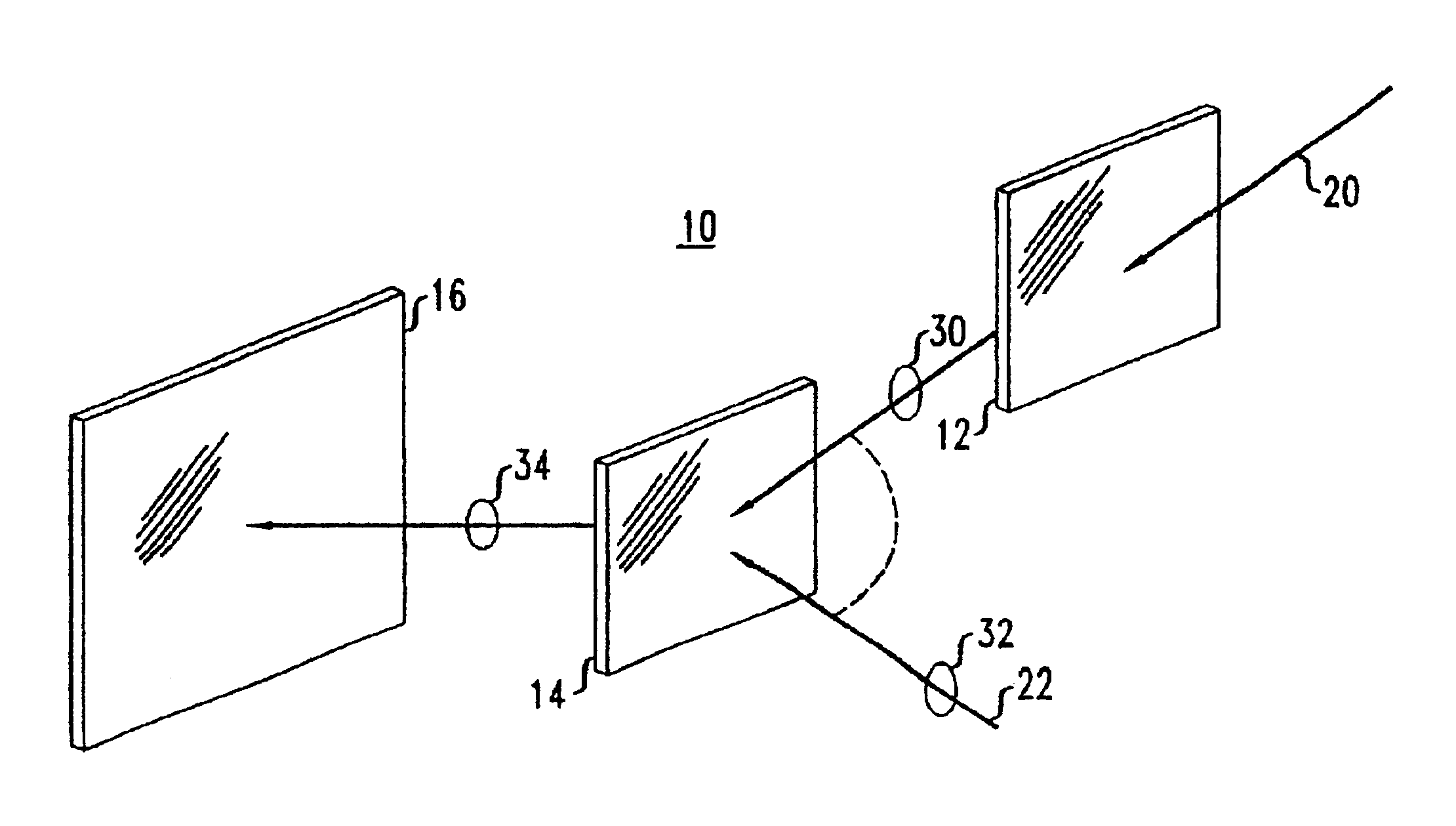Optical article and process for forming article
a technology of optical articles and forming articles, applied in the field of optical articles, can solve problems such as degrading the quality of the medium, and achieve the effect of avoiding phase separation
- Summary
- Abstract
- Description
- Claims
- Application Information
AI Technical Summary
Benefits of technology
Problems solved by technology
Method used
Image
Examples
example 1
[0045]A solution was prepared containing 98.86 wt. % 4-chlorophenyl acrylate and 1.14 wt. % dibutyltin dilaurate. 0.017 g of this solution was added to a vial containing 0.2519 g diisocyanate-terminated polypropylene glycol (MW=2471), 0.047 g α,ω-dihydroxypolypropylene glycol (MW=425), 0.051 g 4-chlorophenyl acrylate, and 0.00063 g Ciba CGI-784 (photoinitiator). The mixture was thoroughly mixed and allowed to cure overnight at room temperature, while protected from light. The polymerization was a step polymerization of the isocyanate groups with the hydroxyl groups to form a polyurethane with dissolved chlorophenyl acrylate monomer. The mixture appeared clear and transparent to the naked eye. Upon exposure to an intense tungsten light, which initiated polymerization of the acrylate monomer, the sample remained clear and transparent, indicating the compatibility of the monomer and the matrix polymer.
example 2
[0046]0.00265 g Ciba CGI-784 was dissolved in 0.26248 g styrene (photoactive monomer). The solution was mixed with 1.9187 g polypropyleneglycol diglycidyl ether (MW=380) (PPGDGE) (matrix precursor), 1.2428 g pentaerythritoltetrakis(mercaptopropionate) (PETMP) (matrix precursor), and 0.1445 g tris(2,4,6-dimethylaminomethyl)phenol (TDMAMP) (catalyst for matrix formation). The mixture was dispensed on a glass slide, into an approximately 200 μm thick, 25 mm diameter Teflon spacer, and second glass slide was placed thereon. After about one hour at room temperature, the mixture gelled due to the amine-catalyzed copolymerization of the mercaptan with the epoxy. Differential scanning calorimeter (DSC) and Fourier transform infrared (FTIR) measurements indicated that polymerization of the matrix was complete after two hours (i.e., no measurable amount of precursor functional groups). A tough, elastomeric material was obtained, consisting of an epoxy-mercaptan matrix containing dissolved sty...
example 3
[0047]To increase the An of the medium above that produced from Example 2, bromostyrene monomer was used as the photoactive monomer. 0.01262 g Ciba CGI-784 was dissolved in 0.2194 g 4-bromostyrene (photoactive monomer). The solution was mixed with 0.9597 g PPGDGE, 0.6042 g PETMP, and 0.084 g TDMAMP. Samples were prepared and holograms recorded as in Example 2. An average Δn of 4.2×10−3 was attained. Again, no abnormal light scattering was detected after holographic recording, and, in addition, DSC showed only one glass transition temperature, suggesting a compatible system.
PUM
| Property | Measurement | Unit |
|---|---|---|
| elastic modulus | aaaaa | aaaaa |
| thickness | aaaaa | aaaaa |
| thickness | aaaaa | aaaaa |
Abstract
Description
Claims
Application Information
 Login to View More
Login to View More - R&D
- Intellectual Property
- Life Sciences
- Materials
- Tech Scout
- Unparalleled Data Quality
- Higher Quality Content
- 60% Fewer Hallucinations
Browse by: Latest US Patents, China's latest patents, Technical Efficacy Thesaurus, Application Domain, Technology Topic, Popular Technical Reports.
© 2025 PatSnap. All rights reserved.Legal|Privacy policy|Modern Slavery Act Transparency Statement|Sitemap|About US| Contact US: help@patsnap.com


